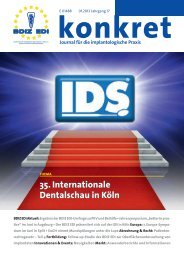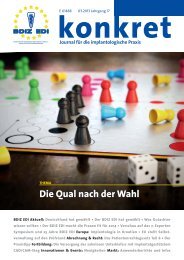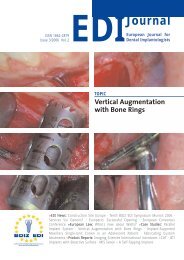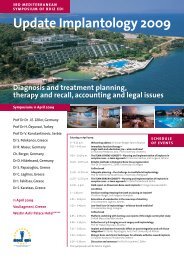Editorial_lay:Layout 1 - BDIZ EDI
Editorial_lay:Layout 1 - BDIZ EDI
Editorial_lay:Layout 1 - BDIZ EDI
You also want an ePaper? Increase the reach of your titles
YUMPU automatically turns print PDFs into web optimized ePapers that Google loves.
Figs. 33a to c<br />
Postoperative<br />
radiological<br />
situation.<br />
Fig. 34<br />
Clinical situation at<br />
three weeks.<br />
Fig. 35<br />
Orthopantomograph<br />
taken six<br />
weeks after the<br />
surgical procedure.<br />
Figs. 36a to c<br />
Surprisingly<br />
healthy and<br />
stable soft tissues<br />
six weeks<br />
after implant<br />
placement.<br />
33a 33b 33c<br />
34 35<br />
36a<br />
36b<br />
36c<br />
<strong>EDI</strong> 51<br />
Case Studies<br />
place (Figs. 32a and b), following a procedure that she<br />
found hardly traumatic at all and which took only<br />
three hours, of which only the first 40 minutes had<br />
been dedicated to surgery. The remainder of the time<br />
had gone to the necessary prosthetic adjustments,<br />
during which the patient felt completely at ease and<br />
was even able to rise from her chair and chat with<br />
the treatment team.<br />
At the postoperative radiological follow-up (Figs.<br />
33a to c), the implants appeared well-placed and in<br />
accordance with the original treatment plan.<br />
The postoperative stage was uneventful; at the<br />
eight-day recall, the patient expressed her surprise<br />
over how much had been achieved and reported to<br />
be completely asymptomatic with no signs of inflammation.<br />
She was subsequently placed on weekly<br />
recalls, which were also uneventful (Fig. 34).<br />
At six weeks after the procedure, no problems of<br />
any kind had occurred, and the radiological follow-up<br />
was also reassuring (Fig. 35).<br />
Also at six weeks after the procedure, we took a position<br />
impression of the implants to fabricate a new provisional<br />
restoration capable of conditioning the soft<br />
tissues even better than the previous one. When we<br />
removed the first provisional, the healing process had<br />
already progressed beautifully, with the keratinized tissues<br />
being surprisingly stable (Figs. 36a to 37c).









